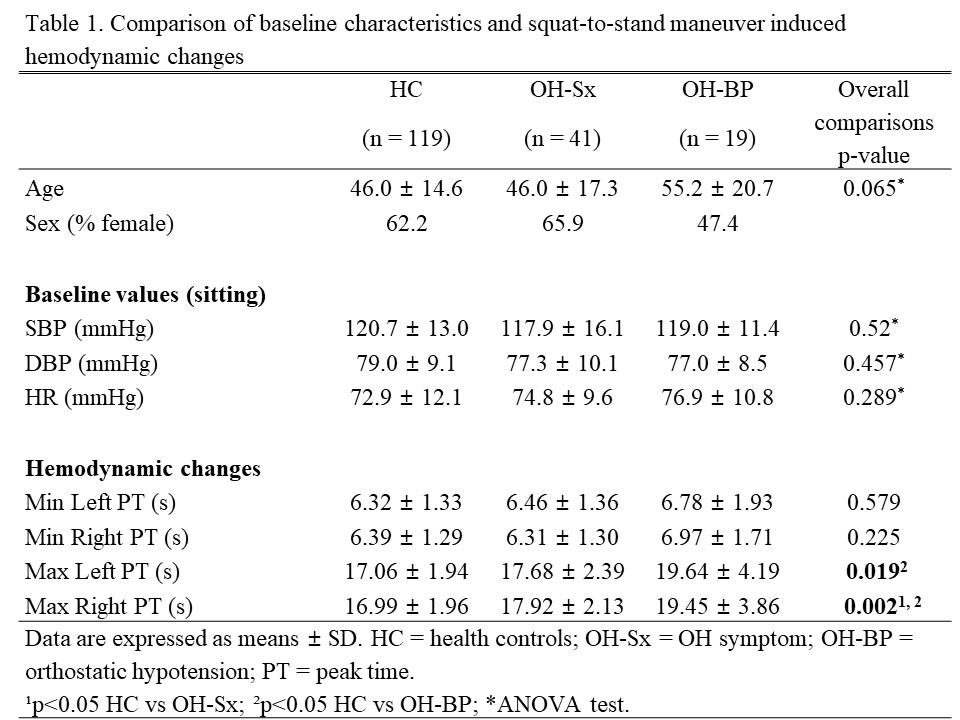초록 미리보기
- 접수번호 : 620564
Evaluation of orthostatic hypotension by cerebral autoregulation using near-infrared spectroscopy during squat-to-stand maneuvers.
Jae-Myoung Kim1, Hyo Eun Park2,3, Heesun Lee2,3, Kyung-Il Park4,5, Hyeon-min Bae1 and Su-Yeon Choi2,3
1Electrical Engineering, Korea Advanced Institute of Science and Technology (KAIST), Daejeon, Korea
2Department of Internal Medicine, Healthcare System Gangnam Center, Seoul National University Hospital, Seoul, Korea
3Department of Internal Medicine, Seoul National University College of Medicine, Seoul, Korea
4Department of Neurology, Seoul National University Hospital Healthcare System Gangnam Center, Seoul, Korea
5Department of Neurology, Seoul National University College of Medicine, Seoul, Korea
Background: Orthostatic hypotension (OH) is caused by autonomic nervous dysfunction that compromises cerebral blood flow regulation resulting in fainting. Conventionally, OH is diagnosed as orthostatic BP fall in lying-to standing or tilt-table test.
Objectives: We investigated that near-infrared spectroscopy (NIRS) measuring cerebral autoregulation (CA) was an effective tool to diagnose OH.
Methods: We investigated 179 volunteers, 19 patients with OH (OH-BP) diagnosed as supine-to-stand fall in SBP ≥20 mmHg or DBP ≥10 mmHg, 41 patients with OH symptom (OH-Sx) categorized by using OH symptom assessment scale over 4 without diagnostic orthostatic BP change, and 119 healthy controls (HC) without any CA problems. A continuous-wave NIRS system (NIRSIT, OBELAB Inc.) was used to measure total hemoglobin concentration (HbT) changes in the forehead at a sampling frequency of 8.13 Hz during 2-min squat followed by standing for 9min. The changes were averaged and merged in two channels (i.e. left and right), then the time differential of HbT (dHbT/dt: DHbT) was extracted. CA was evaluated by measuring the peak time (PT) of the minimum and maximum value of DHbT oscillation during the squat-to-stand transition. The groups were compared using ANOVA, Kruskal-Wallis, and post-hoc testing (p<0.05).
Results: At the baseline, the age in OH-BP group was slightly higher, but not significant (p=0.065). The mean SBP, DBP, and HR did not show significant difference between groups. The maximum LPT was significantly longer in OH-BP group (p=0.019). Moreover, the maximum RPT were significantly longer in both OH-Sx and OH-BP groups than HC group (p=0.002). Minimum LPT and RPT were similar in all groups.
Conclusions: The subjects with orthostatic BP fall showed delayed maximum PT when measured with NIRS. The subjects with orthostatic hypotension symptoms also had slightly delayed maximum PT even when there were no definitive orthostatic BP falls. This result suggests the possibility of using NIRS not only as a diagnostic tool but also as an effective method to characterize individual CA.
- Keywords
- Orthostatic hypotenstion, Cerebral autoregulation, Near-infrared spectroscopy, Squat-to-stand maneuvers
